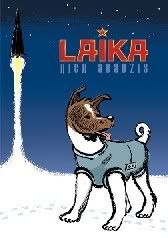
Work with animals is a source of suffering to all of us. We treat them like babies who cannot speak. The more time passes, the more I'm sorry about it. We did not larn enough from the mission to justify the death of the dog.
Oleg Georgivitch Gazenko, 1998
As the title indicates, this graphic novel is a fictionalized retelling of the story of Laika, the soviet dog that, in 1957, became the first living creature to be launched into orbit. She was never brought back. Although at the time the official story was that she survived for 4 days in orbit, and then was mercifully euthanized, the truth of the matter was that Laika died a mere 5 hours after the launch, due to stress and the overheating of the cabin she was in.
Sputnik II, the vessel Laika was launched in, was built in only a month. The goal was for it to be ready for launch in time for the celebration of 40th anniversary of the Bolshevik Revolution. The Soviet Space Program was supposed to symbolize the triumph and superiority of socialism. Although this story portrays the political environment of the time in detail, its focus is, above all, the emotions of those who were, in one way or another, touched by the little dog Laika.
I have mixed feelings about the sacrifice of animals in the name of science. While on an emotional level it can horrify me, intellectually I do know that certain things would be impossible to discover otherwise, and that medicine and biology wouldn't be as advanced as they are today if it weren't for it. What is so tragic about Laika's story, though, is that she wasn't sacrificed in the name of science. Nothing much was learned from Sputnik II. She was sacrificed in the name of a political game of chess. It was the desire to make a political statement that rushed the launch of Sputnik II, and made Laika’s safe return be disregarded.
Nick Abadzis explores the futility of her death brilliantly in this story. We follow Laika - or Kudryavka, as she was initially named - from the day she is born into a family that is too poor to keep her. She is given away to a careless boy who ends up throwing her into a river. She survives, and wanders the streets of Moskow until she is picked up by an animal shelter. There she is selected for training, and ends up being chosen as the occupant of Sputnik II due to her resilience and docile temperament.
I suppose that an easy way to tell this story would have been to anthropomorphise Laika. However, this was not the path that Nick Abadzis chose to follow. While Laika is undoubtedly at the very centre of the story, the human characters are just as important, and their emotions are what carries the story along and gives it the depth and resonance it has. The fact that Laika remains “only” a dog increases her fragility, and therefore the strength of the characters’ (and the reader’s) reaction to her fate.
As for the human characters, there is Liliana, the little girl at whose house she is born, and who never forgets her even after she is forced to give her away. There is Yelena Dubrovsky, the caretaker of the dogs on the Space Program, and the person who feels closest to Laika, and is arguably the most affected by her death. There is Oleg Gazenko, the main scientist behind the program, whose scientific neutrality slowly shatters, and there is Korolev, the ambitious Chief Designer of Sputnik II.
The way these characters’ emotions and motivations are portrayed is subtle and complex, and the final result is exquisite – a story that is very poignant without ever becoming overly sentimental. A touching account of the way certain choices take a greater toll on us than we could foresee. Highly recommended. (Originally posted here.)

No comments:
Post a Comment